From clutter to conversion: How to maintain email list hygiene for better deliverability

Did you know nearly half of all emails sent in 2022 were spam?
Statista reports that, in 2022, spam was up from 46% in 2021. That’s why inbox providers like Gmail and Outlook have advanced spam filters.
So where does that leave email marketers?
First, you need to maintain good deliverability rate to get into as many inboxes as possible. Maintaining a healthy email list is the only way to secure a path toward your subscribers’ inboxes—and, ultimately, guide them toward purchase.
That means it’s critical to have a well-segmented email list that’s full of engaged subscribers—and free of wrong or fake email addresses and unresponsive users.
If that doesn’t sound like your current email list, don’t worry. You don’t need to scrap your email list and start from scratch. Instead, you can prune your list with the email list cleaning practices we’ll show you.
Why is email list hygiene so important?
Keeping a clean email list means keeping your subscriber list full of people who actually want to interact with you—and suppressing emails to folks who aren’t active.
And it’s key to building a high-performing email marketing channel.
Ultimately, it’s better to have a smaller list of more engaged subscribers. You’ll be able to reach their inboxes more effectively—and get your messages across when you need to most.
Let’s examine how a healthy email list impacts your email marketing efforts in terms of deliverability, customer relationships, data, and costs.
A healthy list improves sender reputation—and deliverability
Email deliverability refers to your ability to get emails to your subscribers when using an email marketing service. After all, sending out emails alone doesn’t guarantee a smooth journey from the email server to the recipient’s inbox.
When you send an email, there are a few possible outcomes:
- The email bounces from the recipient’s email server.
- The email service providers (ESPs) block the email or mark it as spam.
- The email arrives in the recipient’s inbox.
The good news is whether your marketing emails reach their destination isn’t random—it depends on your sender reputation.
If you have a good sender reputation, the email provider considers you a trustworthy sender and gets your email into the recipient’s inbox. The worse your email sender reputation, the higher the likelihood your emails end up in the spam folder.
Email providers usually calculate a sender’s reputation based on:
- Emails bounced (hard or soft)
- Spam complaints from recipients
- Past unsubscribes
- Whether the sender sends emails to spam traps
But what does all this have to do with email list hygiene? Let’s say a significant part of your subscriber list consists of invalid email addresses or unengaged recipients. Here’s what may happen when you send emails to that list:
- Hard bounces: The destination mail server rejects the email if the email address is invalid or doesn’t exist anymore.
- Spam folder placement: The recipient finds the email annoying and marks the email as spam.
- Unsubscriptions: The recipient doesn’t find the email interesting and unsubscribes from the list.
Hard bounces, spam complaints, and unsubscribes have one thing in common: They negatively impact a sender’s reputation.
Based on these factors, email providers can decide to blocklist senders. That means their emails won’t even reach the inboxes of engaged customers within that email provider. This is a particularly harsh outcome considering the sender could’ve avoided it by simply cleaning their email list.
A healthy list strengthens your customer relationships
Subscribers who signed up for your email list may eventually lose interest or move away from your brand.
Whether they find another business to buy from, don’t love your product, or just don’t enjoy your emails, not every customer is going to be a loyal one forever.
When you don’t clean your email list regularly, you’re more likely to keep sending emails to these unengaged recipients. That can have many adverse effects, including:
- Recipients mark your emails as spam or unsubscribe—goodbye, good sending reputation.
- Recipients get annoyed—they won’t come back to your brand again.
With email list cleaning, you can move these customers to a separate segment and try to re-engage them. If they still don’t respond, it’s time to say goodbye and remove them altogether.
A healthy list means more accurate email marketing campaign results
A large number of unengaged subscribers can skew the value of your email marketing KPIs.
Let’s say your latest email marketing campaign is showing low open rates and click-through rates. Even if your engaged subscribers respond well to the campaign, you won’t notice it because of the bloated email list.
That’s bad for accuracy. Worse, you may end up ditching something that works. A clean email list will yield more accurate KPI measurements to help you plan future marketing efforts.
A healthy list reduces marketing costs
Most email marketing platforms charge you based on your email volume. So, if you send 10K emails and half of the recipients don’t open them, it’s a waste of money.
A clean email list ensures you spend money on subscribers who are more likely to engage with your emails. Engaged email subscribers are more likely to convert, giving you a better return on investment for your email marketing strategy.
In addition, a clean list helps you save on costs related to fixing deliverability issues with inbox providers.
How to clean an email list in 4 simple steps
Now that you understand why having a healthy email list matters, let’s go over how to clean up your email list, step by step.
1. Suppress invalid and outdated email addresses
First, you need to identify email addresses that cause hard bounces. Emails can’t be delivered to these addresses for a reason that’s permanent, so it’s best to remove them from your list.
Email list cleaning services and email marketing platforms like Klaviyo help you automatically remove an address on the first instance of a hard bounce.
The next thing to look for is soft bounces. These represent temporary issues with delivering your email and can happen because:
- The recipient’s inbox is full
- The email server is down
- The email is too big to be delivered to the inbox
You don’t need to remove addresses that are soft-bounced immediately. Instead, make a protocol for cleaning them.
2. Identify unengaged profiles in your email list
To recap: Some subscribers might no longer be interested in receiving your emails. But identifying unengaged subscribers isn’t as straightforward as detecting bounced emails—you have to first define a baseline.
The baseline should help you determine the criteria for someone to be considered unengaged. For example, if someone subscribed a week ago and hasn’t engaged with any of your emails, it’s too early to classify them as unengaged.
But if it’s been 3 months, it’s a different story.
With your baseline in hand, you can create segments for unengaged subscribers.
Klaviyo recommends the following segmenting criteria for engaged subscribers:
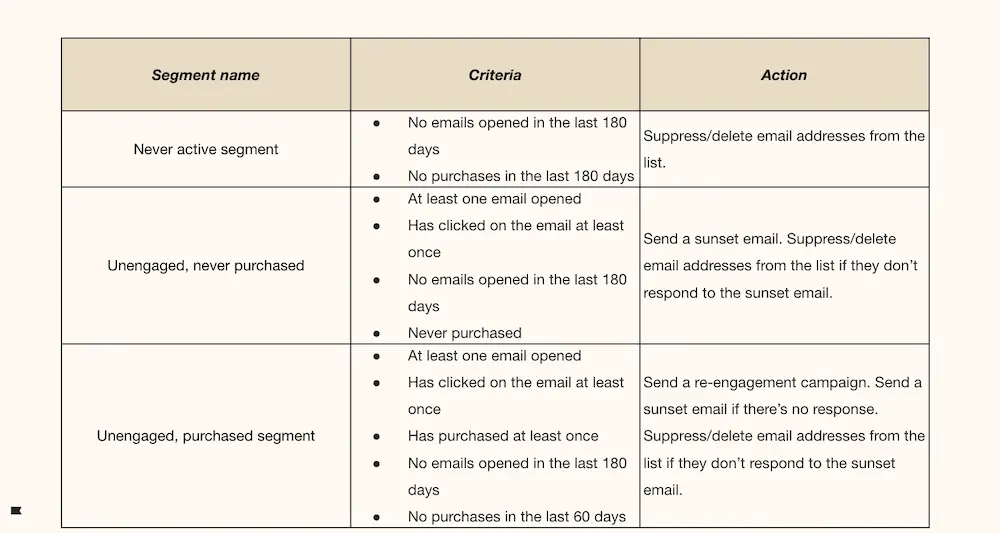
Image source: Klaviyo
You can use this as a jumping-off point, and adjust it for your unique business and customer journeys.
3. Try re-engagement email campaigns
Before removing unengaged customers from your email list, you can try winning them back with a win-back email or re-engagement campaign. The campaign can include emails with coupon codes, free shipping, or other offers to entice subscribers to give your business another try.
Here’s how SKINN does it:

Image source: Klaviyo Showcase
If the subscriber doesn’t respond to the re-engagement flow, though, it might be time to say goodbye with a sunset flow.
Brands often send sunset flow in two parts:
- A re-permission email to get the subscriber’s consent again or give them the opportunity to unsubscribe
- A goodbye email to part ways with the subscriber
Even if someone chooses to unsubscribe, it’ll benefit you. After all, sunset flows let people unsubscribe rather than mark your email as spam—which is far less damaging to your sender reputation.
Here’s the first part of Princess Awesome’s sunset flow:
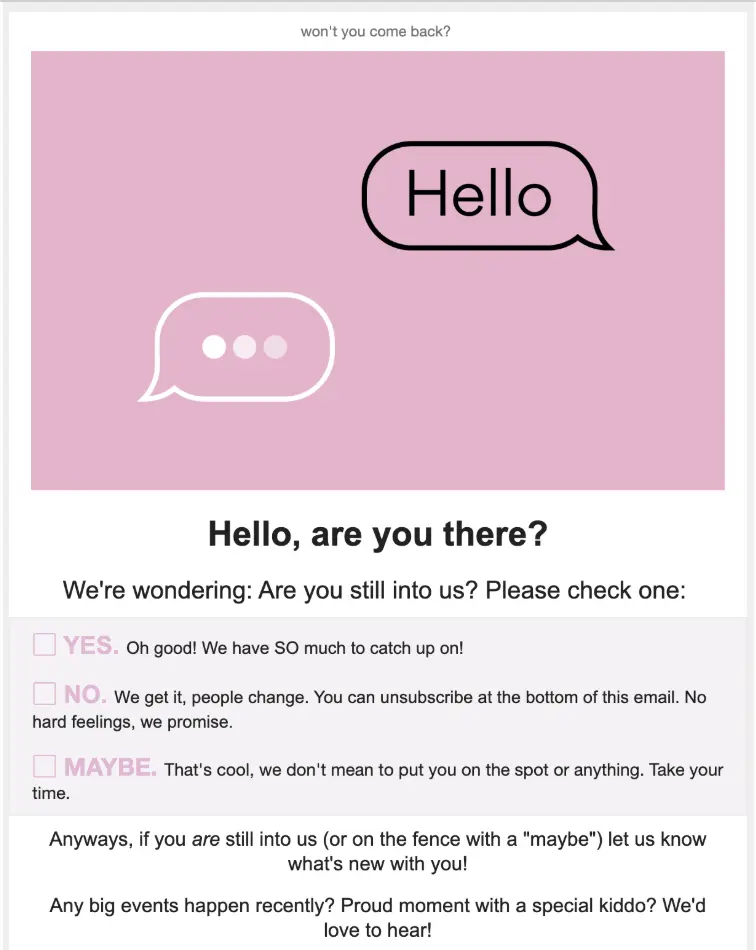
Image source: Princess Awesome
Pro tip: As part of the sunset flow, consider encouraging subscribers to update their preferences rather than unsubscribing completely. This is a great way to reduce the frequency of the email they receive while preserving their contact information.
4. Delete or suppress unengaged profiles
After the re-engagement campaign and sunset flows, you’ll likely win back a few customers. And that’s great—but don’t let it distract you from removing unresponsive subscribers from your email list.
Here are some actions you can take to remove them:
- Delete unresponsive subscribers from your lists.
- Suppress unresponsive subscribers from future email campaigns.
- Create a segment and exclude them from future campaigns.
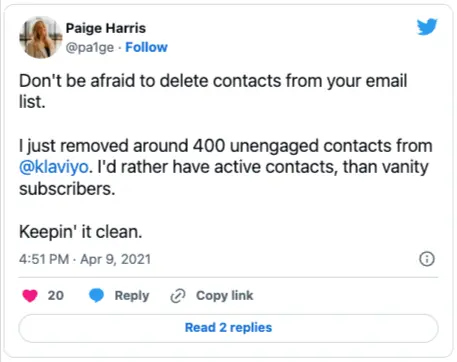
Image source: Twitter
Best practices for maintaining your email lists
Cleaning your email list can make or break your campaigns. But there’s no need for deep dives in the first place if you regularly tend to your email lists.
Here’s what maintaining email list hygiene can look like:
Prioritize engaged subscribers when you send emails
One benefit of email list cleaning is that you’ll get engagement data as a byproduct. You can use that data for creating segments and sending targeted emails to your most engaged customers.
You can also adjust email frequency to less-engaged audiences. That helps ensure your marketing emails don’t annoy low-engaged subscribers and optimizes the cost of sending emails.
Pro tip: Save your biggest and best marketing promotions (like sitewide sales or influencer collaborations) for all your subscribers, while keeping your engaged subscribers in the loop more frequently with consistent brand updates.
Here’s an example of email engagement tracks based on engagement metrics.
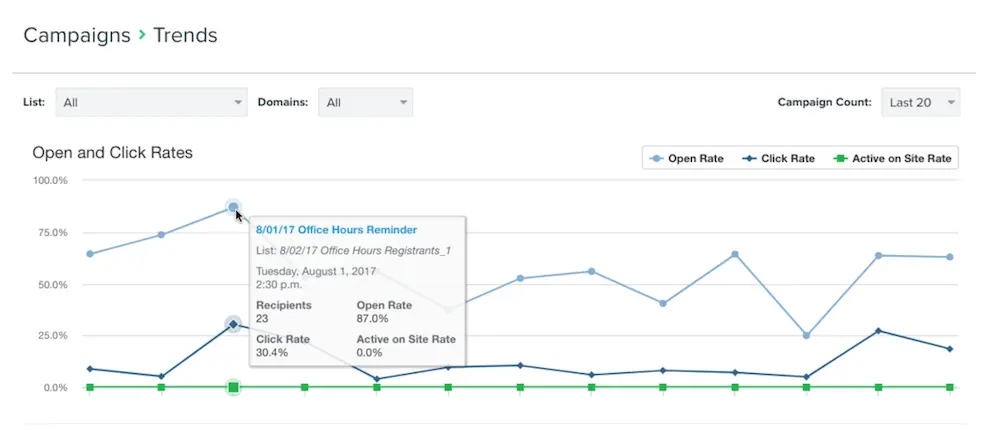
Image source: Klaviyo
Create specific segments
A clean email list means more than just not sending emails to folks who are unengaged. It means segmenting your email list based on behavior.
You can send more emails to those who want to read them—and fewer emails to on-and-off readers. Send customers more of the content they like. And if you pay attention to who’s fading, you can initiate re-engagement campaigns to keep them active.
But you can also go beyond email engagement-based segmentation and create segments based on:
- Demographics
- Geolocation
- Purchase history
- Purchase recency
- Website engagement
- Email engagement
- Predictive analytics
These segments will help you send emails matching your customers’ needs and interests. That lowers their chances of becoming unengaged, which will keep your email list healthy.
Make it easy to unsubscribe
It might be challenging to let go of the subscribers you acquired, but offering an easy unsubscribe option is a smart idea because:
- It gives you a chance to part with the customer on good terms
- It reduces spam complaints that affect your sender reputation
You can also provide an opt-down option to unsubscribe from your emails selectively.
With Klaviyo, it’s very easy to insert an unsubscribe link into your emails. You just need to add a new unsubscribe tag to your email template.
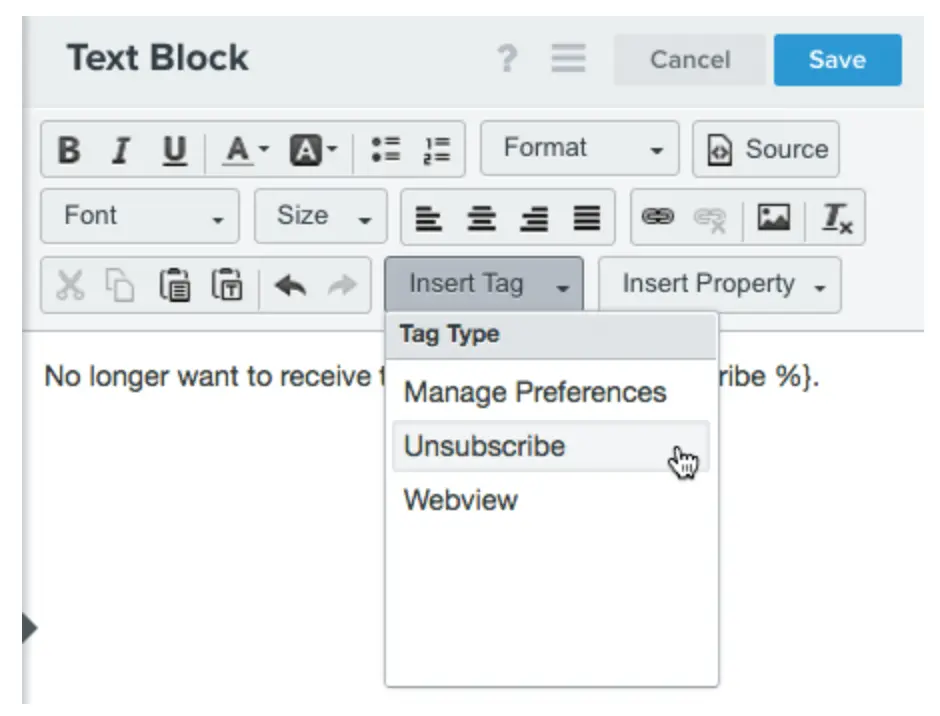
Image source: Klaviyo
Continuously analyze performance
As you go about cleaning your list, you’ll want to make sure you’re clear on the metrics you’re using when making decisions.
Opens never indicated true engagement, but they’ve become even more unreliable as a metric over the past few years. It’s time to move on to more effective metrics to determine subscriber engagement, including:
Clicks to your website
Prioritize click rates. High click rates mean customers are actually engaging with your content.
Use Klaviyo’s benchmarks to establish a baseline to measure success and optimize your email for clicks moving forward.
Recent orders
Tracking recent orders tells you how engaged a subscriber is with your brand beyond direct email engagement.
Just because a customer clicked on your launch email for a line of $200 cashmere sweaters doesn’t mean that they will definitely buy them.
With this information, you can send customers the right emails based on what they’ve actually purchased.
On-site behavior
Clicks alone don’t offer a complete picture of a subscriber’s engagement. Knowing how a customer is interacting with your website can add a missing piece of the puzzle.
After a customer has clicked in your email, what are they doing on your website? Are they browsing products? Adding to their cart? Exploring your blog?
Connecting the dots can help you build a complete customer profile. Then, you can send the content that results in meaningful actions on your website—and skip those that don’t.
Recency of sign-up
Don’t suppress new subscribers too early. Give them a chance to show that they’re engaged with your brand. Keep sending emails to those who joined in the last 6 months—regardless of engagement.
And remember: First impressions are crucial. Send new subscribers a welcome series to establish their relationship with your brand and ensure future engagement.
Email recency
Your emails should work cooperatively. If you have several active campaigns going out to customers, you don’t want them to overlap. Otherwise, customers will feel overwhelmed and engage with fewer emails. Keep your engagement rate high by accounting for how recently someone received an email before sending them another one.
Your customers’ behaviors and preferences enable you to personalize your communications for better acquisition and retention, ultimately creating a more loyal customer base.
Monitoring your KPIs will help you invest more effort in strategies that work—and pull back on marketing methods that don’t yield results.
Email hygiene: the gift that keeps on giving
Spring cleaning can be a tedious, time-consuming process. Or, if you’ve kept your home tidy year-round, it can be a pleasant ritual that makes you more comfortable in your space.
Think of email list hygiene like that: the benefits far outweigh the efforts.
Email hygiene FAQs
How do I know if my list needs to be cleaned?
Some signs that your list needs cleaning include:
1. A decline in engagement, such as low open and click rates
2. An increase in bounce rates
3. An increase in unsubscribe and spam complaints
How often should I clean my lists?
If you have under 50K contacts, once a year should be enough. But if your list is growing quickly, we recommend cleaning it every 6 months. And be sure to give it a look before large shopping events like BFCM.
How do I clean my email list?
Clean your email list by suppressing invalid and outdated email addresses, identifying unengaged profiles in your email list, trying re-engagement email campaigns, and deleting or suppressing unengaged profiles.




